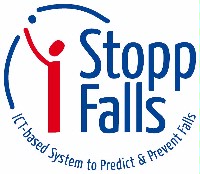iStoppFalls: ITC-based System to Predict & Prevent Falls
Zum 1. Oktober 2011 startet unter der Federführung des Instituts für Wirtschaftsinformatik und Neue Medien der Universität Siegen unter der Leitung von Prof. Dr. Volker Wulf ein europäisches Forschungsprojekt zur Sturzprävention und -vorhersage bei alten Menschen, die eigenständig zu Hause leben.
Ob Treppenstufe, rutschiger Untergrund oder Trittunsicherheit durch altersbedingt nachlasssende Physis: Stürze und deren Folgen stellen ein immenses und zunehmendes Gesundheits- und Kostenproblem unserer Gesellschaft dar. Nicht zuletzt die demographisch bedingte veränderte Altersstruktur wird diese Problematik in Zukunft weiter verschärfen. Prophylaxe und Vermeidung von sturzbedingten Unfällen: dieses Forschungsfeld rückt sowohl national als auch auf europäischer Ebene zunehmend in den Fokus, um moderne, kostengünstige und alltagstaugliche Lösungen zur Sturzvermeidung zu entwickeln. Der aktiven Sturzprävention, vor allem durch gezielte Bewegungs- und Trainingsprogramme, kommt hier eine entscheidende Rolle zu. Dabei können moderne Informations- und Kommunikationstechnologien (IKT) aus den Bereichen Sensorik, Telemedizin und Home-Entertainment (Xbox/Kinect) entsprechende Aktivitäten unterstützen, da sie bei zielgruppengerechter Gestaltung zunehmend auch von alten Menschen zu Hause genutzt werden können.
Ziel des Forschungsprojektes ist es, IKT-basierte Technologien zu entwickeln, die einfach und kostengünstig in das tägliche Leben der älteren Mitbürger integriert werden können. Durch unaufdringliche Messtechnologien sowie lernfähige Assistenzfunktionen kann so sowohl eine effektive Prävention als auch eine zuverlässige Vorhersage von Stürzen ermöglicht werden. „Insbesondere die nachhaltige Aktivierung von älteren Mitbürgern zu selbständigen Training daheim, das durch geeignete Techniken initiiert, angeleitet und überwacht wird, ist gleichzeitig Potential und Herausforderung unseres Forschungsprojekts“ erklärt Dr. Rainer Wieching, Leiter und Initiator des Projekts an der Universität Siegen. „Ein erfolgreiches Projekt führt so zu einer verbesserten Lebensqualität für den Einzelnen und zu reduzierten Kosten für die Gesellschaft“.
Die Universität Siegen koordiniert das europäische FP7 Forschungsprojekt sowohl wissenschaftlich als auch technisch. Beteiligte Projektpartner sind die Deutsche Sporthochschule (Köln), das Austrian Institute of Technology (Österreich), das Instituto Biomechanica de Valencia (Spanien), Philips Research Europe (Niederlande), Kaasa Solution (Düsseldorf) und Neuroscience Research Australia (Sydney). Das Forschungsvorhaben wird unter dem Titel iStoppFalls (ICT based System to Predict and Prevent Falls) von der Europäischen Kommission mit ca. 3,75 Millionen Euro gefördert.
Das Institut für Wirtschaftsinformatik & Neue Medien der Universität Siegen übernimmt hierbei neben dem kompletten internationalen Projektmangement Aufgaben in den Forschungsbereichen Human Computer Interaction (HCI), interaktive TV Forschung und für die Anwendung empirische Methoden in Bereich der IKT-Entwicklung. Dabei wird die nutzer-zentrierte und praxis-orientierte IKT-Entwicklung betont, welche sich durch partizipative Aktionsforschung manifestiert. Auf dem Gebiet Participatory Design besitzt das Institut langjährige Erfahrung.
Das Projekt „iStoppFalls“ profitiert von der interdisziplinären Aufstellung des Lehrstuhls/Instituts (Informatik, BWL, Soziologie, Psychologie), von der Expertise im Bereich gemeinschaftsorientierter interaktiver TV- und mobiler Anwendungsentwicklung, sowie der praxis- und nutzer-orientierten Entwicklungsmethodik (u.a. Living Lab Ansatz), die allen Aktivitäten zugrunde liegt.
Weitere Informationen unter www.istoppfalls.eu
Publikationen
2014
-
Gschwind, Y. J., Eichberg, S., Marston, H., Ejupi, A., de Rosario, H., Kroll, M., Drobics, M., Annegarn, J., Wieching, R., Lord, S. R., Aal, K. & Delbaere, K. (2014)ICT-based system to predict and prevent falls (iStoppFalls): study protocol for an international multicenter randomized controlled trial.
IN BMC geriatrics, Vol. 14, Pages: 91 doi:10.1186/1471-2318-14-91
[BibTeX] [Abstract] [Download PDF]BACKGROUND: Falls are very common, especially in adults aged 65 years and older. Within the current international European Commission’s Seventh Framework Program (FP7) project ‚iStoppFalls‘ an Information and Communication Technology (ICT) based system has been developed to regularly assess a person’s risk of falling in their own home and to deliver an individual and tailored home-based exercise and education program for fall prevention. The primary aims of iStoppFalls are to assess the feasibility and acceptability of the intervention program, and its effectiveness to improve balance, muscle strength and quality of life in older people. METHODS/DESIGN: This international, multicenter study is designed as a single-blinded, two-group randomized controlled trial. A total of 160 community-dwelling older people aged 65 years and older will be recruited in Germany (n = 60), Spain (n = 40), and Australia (n = 60) between November 2013 and May 2014. Participants in the intervention group will conduct a 16-week exercise program using the iStoppFalls system through their television set at home. Participants are encouraged to exercise for a total duration of 180 minutes per week. The training program consists of a variety of balance and strength exercises in the form of video games using exergame technology. Educational material about a healthy lifestyle will be provided to each participant. Final reassessments will be conducted after 16 weeks. The assessments include physical and cognitive tests as well as questionnaires assessing health, fear of falling, quality of life and psychosocial determinants. Falls will be followed up for six months by monthly falls calendars. DISCUSSION: We hypothesize that the regular use of this newly developed ICT-based system for fall prevention at home is feasible for older people. By using the iStoppFalls sensor-based exercise program, older people are expected to improve in balance and strength outcomes. In addition, the exercise training may have a positive impact on quality of life by reducing the risk of falls. Taken together with expected cognitive improvements, the individual approach of the iStoppFalls program may provide an effective model for fall prevention in older people who prefer to exercise at home. TRIAL REGISTRATION: Australian New Zealand Clinical Trials Registry Trial ID: ACTRN12614000096651.International Standard Randomised Controlled Trial Number: ISRCTN15932647.
@article{gschwind_ict-based_2014, title = {{ICT}-based system to predict and prevent falls ({iStoppFalls}): study protocol for an international multicenter randomized controlled trial.}, volume = {14}, issn = {1471-2318}, url = {http://bmcgeriatr.biomedcentral.com/articles/10.1186/1471-2318-14-91 http://www.pubmedcentral.nih.gov/articlerender.fcgi?artid=4145835%7B&%7Dtool=pmcentrez%7B&%7Drendertype=abstract}, doi = {10.1186/1471-2318-14-91}, abstract = {BACKGROUND: Falls are very common, especially in adults aged 65 years and older. Within the current international European Commission's Seventh Framework Program (FP7) project 'iStoppFalls' an Information and Communication Technology (ICT) based system has been developed to regularly assess a person's risk of falling in their own home and to deliver an individual and tailored home-based exercise and education program for fall prevention. The primary aims of iStoppFalls are to assess the feasibility and acceptability of the intervention program, and its effectiveness to improve balance, muscle strength and quality of life in older people. METHODS/DESIGN: This international, multicenter study is designed as a single-blinded, two-group randomized controlled trial. A total of 160 community-dwelling older people aged 65 years and older will be recruited in Germany (n = 60), Spain (n = 40), and Australia (n = 60) between November 2013 and May 2014. Participants in the intervention group will conduct a 16-week exercise program using the iStoppFalls system through their television set at home. Participants are encouraged to exercise for a total duration of 180 minutes per week. The training program consists of a variety of balance and strength exercises in the form of video games using exergame technology. Educational material about a healthy lifestyle will be provided to each participant. Final reassessments will be conducted after 16 weeks. The assessments include physical and cognitive tests as well as questionnaires assessing health, fear of falling, quality of life and psychosocial determinants. Falls will be followed up for six months by monthly falls calendars. DISCUSSION: We hypothesize that the regular use of this newly developed ICT-based system for fall prevention at home is feasible for older people. By using the iStoppFalls sensor-based exercise program, older people are expected to improve in balance and strength outcomes. In addition, the exercise training may have a positive impact on quality of life by reducing the risk of falls. Taken together with expected cognitive improvements, the individual approach of the iStoppFalls program may provide an effective model for fall prevention in older people who prefer to exercise at home. TRIAL REGISTRATION: Australian New Zealand Clinical Trials Registry Trial ID: ACTRN12614000096651.International Standard Randomised Controlled Trial Number: ISRCTN15932647.}, number = {1}, journal = {BMC geriatrics}, author = {Gschwind, Yves J and Eichberg, Sabine and Marston, Hannah and Ejupi, Andreas and de Rosario, Helios and Kroll, Michael and Drobics, Mario and Annegarn, Janneke and Wieching, Rainer and Lord, Stephen R and Aal, Konstantin and Delbaere, Kim}, month = jan, year = {2014}, pmid = {25141850}, keywords = {PRAXLABS, iStopFalls}, pages = {91}, annote = {ISBN: 978-1-4673-7300-5}, } -
Müller, C., Schorch, M. & Wieching, R. (2014)PraxLabs as a Setting for Participatory Technology Research and Design in the Field of HRI and Demography
Proceedings of the Workshop „Socially Assistive Robots for the Aging Population: Are we trapped in Stereotypes?“, Human Robot Interaction Conference. Bielefeld, Publisher: Bielefeld University
[BibTeX]@inproceedings{muller_praxlabs_2014, address = {Bielefeld}, title = {{PraxLabs} as a {Setting} for {Participatory} {Technology} {Research} and {Design} in the {Field} of {HRI} and {Demography}}, booktitle = {Proceedings of the {Workshop} "{Socially} {Assistive} {Robots} for the {Aging} {Population}: {Are} we trapped in {Stereotypes}?", {Human} {Robot} {Interaction} {Conference}}, publisher = {Bielefeld University}, author = {Müller, Claudia and Schorch, Marén and Wieching, Rainer}, year = {2014}, keywords = {italg, CSCW, iStopFalls}, } -
Aal, K., Ogonowski, C., Rekowski, T. V., Wieching, R. & Wulf, V. (2014)A Fall Preventive iTV Solution for Older Adults
Proceedings of TVX’14, Demo Presentation., Pages: 1–2
[BibTeX]@inproceedings{aal_fall_2014, title = {A {Fall} {Preventive} {iTV} {Solution} for {Older} {Adults}}, isbn = {978-1-4503-2838-8}, booktitle = {Proceedings of {TVX}'14, {Demo} {Presentation}}, author = {Aal, Konstantin and Ogonowski, Corinna and Rekowski, Thomas Von and Wieching, Rainer and Wulf, Volker}, year = {2014}, keywords = {PRAXLABS, iStopFalls, praxlabs}, pages = {1--2}, }
2012
-
Meurer, J. & Wieching, R. (2012)Motivating Elderly People to Use Fall Preventive Exercise Training Games at Home: Are Community Based ICT Features Always a Good Choice?
IN Designing for Inter/Generational Communities, Vol. 28
[BibTeX]@article{meurer_motivating_2012, title = {Motivating {Elderly} {People} to {Use} {Fall} {Preventive} {Exercise} {Training} {Games} at {Home}: {Are} {Community} {Based} {ICT} {Features} {Always} a {Good} {Choice}?}, volume = {28}, journal = {Designing for Inter/Generational Communities}, author = {Meurer, Johanna and Wieching, Rainer}, year = {2012}, keywords = {iStopFalls}, } -
Meurer, J., Schöning, S. & Wieching, R. (2012)Empirical analysis of end-user requirements: Designing ICT artifacts for the elderly exercising at home.
IN Journal of Aging and Physical Activity, Vol. 20
[BibTeX]@article{meurer_empirical_2012, title = {Empirical analysis of end-user requirements: {Designing} {ICT} artifacts for the elderly exercising at home.}, volume = {20}, journal = {Journal of Aging and Physical Activity}, author = {Meurer, Johanna and Schöning, Sima and Wieching, Rainer}, year = {2012}, keywords = {iStopFalls}, }


 Laufzeit: 2011-2014
Laufzeit: 2011-2014